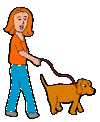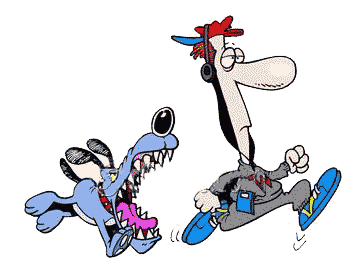|

Steve
Zawistowski
Dog Bites and
Breed Legislation
Over 300
American towns and cities have enacted some form of legislation
that restricts ownership of specific dog breeds. In addition, a number of
insurance companies are not writing new home owners’ policies if the
applicant owns one or another specific breed of dog. These actions are
being taken as a response to a perceived greater risk posed to public
safety by certain breeds such as pit bulls, Chow chows, Rottweilers and
others. This is happening even though there are no clear data
demonstrating such an increased risk. Efforts to have dangerous dog laws
concentrate on “deeds, not breeds” can be difficult to enact and implement
due to a lack of standards and guidelines on how to evaluate deeds.
I will provide a review of some passed, pending and challenged laws. In
particular I will try to point out areas where behavior is considered, and
how. I would like to initiate a discussion of how behaviorists can
contribute to a standardized, empirically based system for dealing with
dog
bite/attack incidents.
___________________________________________________________________

Peter L.
Borchelt
Dog Bites and
Scratches
I will
present an update on dog bite force data and compare topographies and
forces of bites and scratches. Bite forces were measured using both a new
super high pressure film and a different test material, polyurethane foam.
Dog bites were recorded at much higher pressures than reported last year.
In addition, I will show how bites and scratches differ in topography
(shapes of marks) and present several legal cases in which analysis of
wounds was critical in determining whether or nor dog was declared
dangerous.
______________________________________________________________________

Wayne Hunthausen
Taking the Behavioral History
I will lead a discussion period for attendees to share how they collect
historical information.
Discussion topics will include: Use of pre-appointment history
forms. Owner video recordings. Collection and recording of
oral and observed information during the consult. Use of forms
during the consultation.
_____________________________________________________________________

Amy Marder,
Meghan Rogers, [not attending]/Joan Engel
Title:
PREVALENCE OF CANINE BEHAVIORS IN HOMES
The purpose
of this study was to gather information about the prevalence of, and
perceptions of, problematic dog behavior in owned animals. Questionnaires
were collected from Boston and New York City dog owners. Questions
pertained to aggressive behavior (bare teeth, growl, snap or bite) to
family members, aggressive behavior (bare teeth, growl, bark, snap or
bite) to individuals outside of the family, house soiling, destructive
behavior, barking, escape behavior, behavior when left alone and fear of
people, objects and noises. Respondents were asked if they considered a
behavior to be a problem and if so, to rate the severity and whether they
had considered getting rid of the dog because of the behavior problem.
Respondents were asked to describe the progression of the problem over
time, how they managed it and whether and from whom they had sought help.
Although data
collection continues, we have 325; 260 from females and 65 from males.
Their ages
ranged from 12 to 82 years, 146 have completed college. Ninety-eight
breeds
were
represented..
62% of the
participants reported that over their dog’s life, their dog had behaved in
a
way that they
considered a problem. The most common were barking (24%), jumping up
(23%), house soiling (21.5%), destruction (20.9), aggression to dogs (24,
and aggression to people 18.2 (13%) of the dogs had bitten people. 7.2%
had considered getting rid of their dog due to a behavior problem. The
most common reason was aggression to people.
27% of the dogs exhibited signs of possessive aggression, 13% were
aggressive when handled. 26% of the dogs showed signs of protective
aggression to unfamiliar people and 11% anxiety when left alone. 32%
showed signs of fear associated with thunder, 28% fireworks and 24% of
vacuums.
______________________________________________________________________

Joan M.
Engel
Title:
Internet resources for pet owners
If you have a
dog or cat with a behavior problem, what are the
internet
resources available when you search for help? The results
of searches
for behavioral help will be presented.
_____________________________________________________________________

Kim Barry,
Val Masters, Melanie McLeroy, Diane Mollaghan, Nancy Williams
Dog
Temperament
This panel
will examine the following topics:
Temperament
dimensions
In order to
create a model to study temperament of domestic dogs, we first define the
temperament traits that exist. Thus far, researchers have failed to come
to a consensus of opinion on this matter. The reason for the apparent
disparity in research may stem from the fact that temperament is often
assessed with different objectives in mind. Personality traits such as
aggressiveness, excitableness, playfulness and anxiousness maybe relevant
in obtaining a personality profile for a pet dog, but many of these traits
may differ or at least be interpreted differently when it comes to
assessing personality of a working dog.
How do we
measure it?
The next step
in this process involves the creation of a diagnostic tool to accurately
assess these
temperament traits. Akin to human personality studies, most empirical
assessments of personality have not been faithful to the conceptual
definition of a trait, and too often only one criterion is used resulting
in weak correlation. Many temperament traits consist of broad dimensions,
which need to be measured by looking at behaviors multiple times in
different contexts, in order to obtain an aggregate measure of behavior
(Epstein). However care must be taken that the achievement of reliability
is not at the expense of validity. Both psychological and physiological
measures of traits will be examined.
Pet matching
About
choosing their ideal pet. Two important criteria in predicting
decision-making success have been identified: previous pet-owning
experience and temporal factors, such as the amount of time adopters spent
making their decision (Ledger, 2000). People with little experience may
be more prone to make decisions based on less information, and in shorter
time vs. those who have experience and are vested in gaining background
knowledge. Do certain adopters reach their decisions based on affect or
cognition or both? Serpell had examined the role of owner perception of
behavior problems as a function of attachment. Given that levels of
attachment can be predicted prior to adoption, does an individual’s
decision-making criteria (affect and/or cognition) also influence
subsequent perceptions of problem behaviors in the home?
Personality
assessment: How well people identify the personality traits they seek in a
pet. (Once they have identified their choice they could report in
retrospect and compared to how they intended to choose )Did they utilize
behavioral information made available from temperament test, pet history
or based on their own experience interacting with the pet. How does their
own human personality traits influence their choice, are people seeking
traits that are similar or different from their own. Do people project
their own personality traits inadvertently on the dogs they choose?
(When these are not consistent, is this a reason for a mismatch?)
______________________________________________________________________
John C.
Wright
Does priming
for quality of temperament affect subsequent ratings of dogs’
adoptability?
This study
was done in order to determine if judgments of shelter dogs’ temperament
and
adoptability
were influenced by raters’ prior exposure to an “actor” (dog) behaving in
either an aggressive or friendly manner. Our hypothesis was that raters’
judgments of different dogs’ adoptability (e.g., a German shepherd,
Collie, German Short Hair Pointer, and Bassett) would be differentially
influenced by schema-consistent information regarding the breed (a German
shepherd) and the temperament (aggressive or friendly) of the actor dog.
Specifically,
we thought that people would attribute negative or positive
characteristics
only to dogs
of the same breed as the actor behaving in either an aggressive or
friendly manner, respectively. Results of the judgments of both men and
women raters and implications of the study will be presented.
_______________________________________________________________________
Crista L.
Coppola (Presenter), Temple Grandin and R. Mark Enns
Influence of
human interaction on salivary cortisol: Can human contact reduce stress
for dogs in a public animal shelter?
Animal
shelters are an extremely stressful environment for a dog, most
specifically due to social isolation and novel surroundings. The stress
response of dogs housed in this environment may be alleviated through
human interaction shortly after arrival. During their second day in a
public animal shelter, adult stray dogs were either engaged in a human
contact session or not. The session involved taking the dog into an
outdoor enclosure, playing with the dog, grooming, petting and reviewing
basic obedience commands. Each dog interacted with a human for
approximately 45 minutes. Salivary cortisol levels were examined from
each dog on their 2nd, 3rd 4th and 9th day of housing. Animals that
engaged in a human contact session had lower cortisol levels on day 3 than
animals that did not. On this day, male dogs also tended to have a lower
cortisol level than females. No other differences were seen between
treatments or sexes on days 2, 4 or 9. Breed type and age did not have an
effect on cortisol levels on any day measured. A human interaction
session can be beneficial to both animal welfare and adoption procedures.
The current study not only utilized the human contact session as a
treatment to reduce stress but also as a means to acquire temperament
information on individuals to assist in compatible adoptions. Human
interaction may be an effective means of reducing the cortisol response of
dogs in the aversive shelter environment.
_____________________________________________________________________
Lauren Hays
Effects of a
Standardized Obedience Program on Approachability and Problem Behaviors in
Dogs from Rescue Shelters.

Improved
adoptability is a common goal among rescue shelters. Dogs are more likely
to be adopted if they are friendly, mannerly, and approachable. The
possibility of improving rescue shelter dogs’ behavior through an
obedience program has not been examined. We developed an approachability
test to determine whether dogs became more approachable during and after a
standardized 12-week obedience program. We also quantified jumping
behavior and pulling on the leash to measure if these problematic
behaviors also improved through training. The subjects consisted of 26
dogs donated to the Triple Crown School for Professional Dog Trainers for
one of the 12-week sessions. The approach test was administered six
times, at two-week intervals. The tests were videotaped and jumping and
pulling behaviors were quantified after testing. Scores for
approachability were based on the proximity between the tester and the dog
at the end of each test. For the dogs that completed all 12 weeks of the
study, contingency analyses were performed for each behavioral measure.
Relative to the start of the 12-week training program, the dogs became
more approachable (p<0.025), jumped less (p<0.025), and pulled on the
leash less (p<0.025) than when the study began. These results reinforce
the importance of obedience training as a tool for increasing a rescue
shelter dog’s adoptability and permanence once placed in
a home.
DISCUSSION:
Is this a
feasible option (time budget-wise) for rescue shelters?
Would
rudimentary obedience training for only a few weeks be of long term value
to the dog and the family?
What are
other ways that rescue shelters could help prevent common problem
behaviors before they become a cause for the dog's return?
__________________________________________________________________
P. Borchelt,
D. Estep, S. Hetts, M.L. Nitschke, M. Shyan-Norwalt, N., Williams,V. Voith
Panel on
Growing the Field
Last year, we
spent several hours in discussions and decided to investigate the
feasibility of forming an educational program somewhere between full ABS
certification and what is presently available to dog trainers. This was
precipitated by the formation of several groups that claim to train "pet
counselors" or "behavioral consultants". In the last year, we have found
that community colleges generally do not offer animal behavior and animal
learning courses, and that on-line courses from high quality programs in
accredited universities are readily available. We ….. will give an
overview of the situation (which has changed in the last year), present
options for potential students to get basic courses from high quality
programs, and show how similar programs are working currently in other
fields (e.g., nursing, veterinary technology). This type of program could
work for dog trainers, veterinarians, veterinary technicians, shelter
staff, second (or higher order) careerists, and retread psychologists or
other mental health professionals.

________________________________________________________________________
Barbara
Pezzanite
Arousal conditioned to people leaving
Classic behaviors of dogs experiencing
separation anxiety include following the owner from room to room,
whimpering, jumping on the owner as the owner tries to leave, then barking
and scratching at the door after the owner has left. But what of the dog
that becomes frantic when anyone leaves the apartment, chasing and nipping
at the person’s derriere, then hopping on the couch and falling asleep
once the individual has left? The odd behavior must have to do with the
leaving itself, not the separation. How does this unusual behavior
develop? Meet Pugsley, a 3-year old male Pug whose owner contacted the
ASPCA for a consultation. Neither Pugley’s owners nor close relatives could leave the apartment without the feel of
this 15 lb Pug’s teeth nipping at their backside. The behavior
developed after the birth of her son. Why?
owners nor close relatives could leave the apartment without the feel of
this 15 lb Pug’s teeth nipping at their backside. The behavior
developed after the birth of her son. Why?
In the next 20 minutes I’ll present the case
of client X and Pugsley, opening up the discussion for further diagnoses
and treatment options.
Pamela J.
Reid
Case studies:
Modification of Aggression in Shelter Dogs
Working in a shelter provides the behaviorist with a unique glimpse into
what can happen after we complete a client consultation. We provide advice
and guidance but, in the end, it is up to the client to implement our
suggestions. In the shelter, we have the opportunity to “jumpstart” the
process by initiating the animal’s behavior modification program and, if
reasonable progress occurs, the animal is transitioned into an adoptive
home. The adoptive owners are then responsible for continuing the behavior
modification and management protocols. But is this effective? In this
presentation, I’ll introduce you to a few of our more challenging
aggression cases, complete with follow-up information from the owners.
_____________________________________________________________________
Patricia McConnell
STATE OF THE ART OF CANINE
COGNITION
This presentation will be an
inquiry into the current state of knowledge of ethologists, behaviorists
and neurologists into the cognitive abilities of canines. Included will
be discussions of the latest research on problem solving abilities of
dogs, of the interplay of emotions and cognition in mammalian species
and on the current hot topic in cognition and philosophy: the “theory of
the mind.”
D. Glenn Martyn
Abstract: Expanding
Human/Canine Communication - Part II
"Challenging Some Behaviorist
Assumptions"
Part I of "Expanding
Human/Canine Communication" looked at the potential to establish more
complex systems of verbal and visual communication beyond typical single
word or movement cues. Anecdotal evidence was presented supporting the
dog's apparent ability to learn arbitrary human acoustic patterns. Part
II reviews the scientific literature and asks whether additional studies
are necessary to support some behaviorist conclusions - specifically those
relating to "overshadowing" and "positive punishment." Can dog trainers
be taught methods, whereby using a stimulus package to establish stimulus
control is still beneficial despite overshadowing? Can low intensity
punishment be effective in decreasing undesirable behaviors? If so, how
is it applied?
___________________________________________________________________
Alice Moon-Fanelli, Jan Koler - Matznick, Karen London and Mary Lee
Nitschke
Ballet vs. Demolition Derby: What Can Canid Play Styles Tell Us?
Since Lorenz's early works, comparing the social behavior of the
domestic dog (Canis familairis) to that of the gray wolf (Canis lupus),
and explaining differences as aberrations caused by domestication, has
been the traditional method for interpreting domestic dog behavior.
Regrettably, this has resulted in a narrow view regarding possible
theories about the evolutionary origins of the domestic dog. The New
Guinea singing dog (NGSD) (Canis hallstromi), has been re-classified as
a feral domestic dog, which we think should be questioned on the grounds
of both scientific and conservation considerations. Preliminary
observations of the NGSD, arguably the most genetically pure population
of primitive dogs still extant, indicate they have truncated or absent
social behaviors compared to both the domestic dog and to the wolf.
Three of us currently live with at least one NGSD and our observations
support the hypothesis that the NGSD has unusual social behavior. In
general, NGSD behavior most closely resembles that of the African
Basenji and the Japanese Shiba Inu. From captive behavior, it has been
suggested that wild NGSDs most likely have a bonded territorial pair
social structure, which is the norm for canids in general. We will
compare the social behavior, particularly play behavior, of a variety of
dogs, both domestic and wild, using video footage of NGSDs, wolves,
Basenjis, Shiba Inus, Malamutes, and Inuit Sled Dogs. Implications for
the evolutionary theory that the domestic dog may have more than one
potential ancestor with very different genetically based social behavior
as well as a new view of the phylogenetic position of the NGSD will be
discussed.

____________________________________________________________________________
Nancy
Williams
Restraint
Equipment and the Power to Stop the Pull
Despite the
many claims made for different types of equipment used to control dogs and
reduce pulling on a leash, there is scant information and no data to
support these product claims. The equipment includes various neck collars,
harnesses, head halters, and leashes. Each manufacturer claims that its
product will reduce pulling in a safe and humane manner.
This study
will collect and analyze data reflecting the dog’s effective pulling power while
restrained by several different commercially available products. In
addition, the session will
compare the results of this pull force study with the claims of the
manufacturers and other proponents of each equipment category.
The goals of
this presentation are to stimulate discussion on the products, their
ability to reduce
pulling per the data, and the implications of the evidence collected to
support the safe and humane use of the product to manage dogs. Future
studies could extend this work to include physiological data collected
during the use of the equipment.
Sophia Yin
Training dogs
to behave at the door using a remote-controlled positive reinforcement
device.
With a
majority of dog training products, development and sales precede the scientific
research for evaluating efficacy. In this presentation I will discuss the
planning and research that preceded final development of the Treat & Train
Dog Training System‹a product for decreasing barking, jumping,
and other
unruly behaviors at the door. This system, which is sold by the Sharper Image
(expected date of release January-February 2005), focuses on positive
reinforcement and a remote-controlled, treat dispensing machine.
In this
presentation I will provide an overview of the two research studies (one
to evaluate the protocol in a simulated doorway situation and a second
clinical trial to evaluate the system in people¹s homes). I will also discuss the
pitfalls encountered during the studies, factors I considered in developing a
protocol for use by the general public, and factors that the clinical
trial revealed were important in teaching owners how to perform the
training.
Pam
Wennmacher
The Effects of Maintaining Behavior with Click + Continuous Food
Reinforcement (CCF) vs. Click + Variable Food Reinforcement (CVF)
In clicker training, dog trainers often use the term “intermittent
reinforcement” when a click is delivered after every correct behavior,
but food is delivered only occasionally. However, when behavior
analysts use intermittent reinforcement, the click and food
reinforcement are always delivered together and the click never occurs
without the food being delivered. Many dog trainers believe that there
is no difference if the click is delivered after every correct behavior,
even without food reinforcement, or if the click is only delivered
immediately preceding food reinforcement. The purpose of this study is
to determine the effects of maintaining behavior with a click +
continuous food reinforcement (CCF) versus a click + variable food
reinforcement (CVF). Two dogs will be trained to lie down and stand-up
on hind legs, until a performance criteria of 80% correct is reached
during baseline. Once at criteria, one behavior (either stand-up or lay
down) will continue to receive continuous food reinforcement, while the
other behavior will be reinforced with food delivery on a variable ratio
(VR) schedule. One dog will receive continuous reinforcement for
stand-ups, while the other dog will receive continuous reinforcement for
lay downs. The clicker will be used to mark every occurrence of the
correct behavior for both dogs, regardless of food delivery. Results
are expected to show a decrease from baseline in the behavior that is
reinforced on the VR schedule for both dogs.
Debra L.
Forthman and Helen M. Hendy [Helen will not be attending. ]
Factors
Associated with the Severity of Canine Aggression
Over the past
year I’ve seen approximately 44 cases of canine aggression (22 males, 22
females). In fourteen (14) of these cases, the owners described their
dogs’ aggression as perplexing, because it was sudden in onset or because
they could see no factor to which to attribute their dogs’ dramatic change
in personality, from an affectionate and biddable animal to one that was
aggressive to dogs, people or both. In intake interviews, the key question
was, “Has anything in your dog’s routine changed recently?” Often clients
did not initially recognize that something had changed around the same
time as the dog’s behavior, but ultimately seven (7) of these clients said
that the only change in the dog’s routine was attendance at daycare. While
the behavior of dogs often changed swiftly and dramatically for the worse
after regular, frequent attendance at daycare, the effects of the use of
pinch collars were generally more subtle and developed over a longer
period of time; five (5) dogs worked in pinch collars developed aggression
problems, as did one (1) dog that attended daycare and wore a pinch
collar. My colleague and I analyzed the data from the aggressive
dogs and from fourteen (14) nonaggressive controls to look for patterns
related to daycare and pinch collars, as well as 1) sex, 2) breed and 3)
whether or not the dog had been rescued. The outcome measure was the
severity of aggression: 0 (no aggression), 1 (dogs only) 2 (people only)
or 3 (both dogs and people). As expected, there were no sex differences,
while breed was the most significant factor, highlighting our role in
counseling people on breed choice. Surprisingly, however, in paired
comparisons, the breeds that were most likely to show aggression were the
toys, which were not significantly different from sheepherding breeds,
with terriers and other breeds, generally the largest dogs, showing the
least severe aggression in this sample. Further, daycare and pinch collars
had no significant effects on aggression. These two were in the
anticipated direction, while rescue, also not significantly associated
with the severity of aggression, had the opposite effect expected, an
encouraging finding. My observations of the owners of toy dogs suggest
that these kind people do not know how to discipline a tiny dog. Having
rejected physical discipline, they have exhausted their options and permit
the dog to engage in increasingly inappropriate behavior. Sheepherding
dogs are high-strung and need "jobs."
We believe that an increased sample of dogs in daycare and those worked
in pinch collars will permit a better analysis of these potential
factors. Analysis of more refined measures of the forms of aggression
may also produce interesting results.

Jennifer
Sobie
Relative
Victim/Aggressor Size As a Variable Affecting Efficacy of Response Cost as
a Treatment in Inter-Dog Aggression in a Multi-Dog Family
Abstract:
Though not inevitable, multi-dog families are sometimes affected by
dog-to-dog aggression. Previous studies by the author have shown
that response-cost in the form of time-out has been effective in
ameliorating these aggressive displays. However, further
evaluation indicates that the relative size of victim to aggressor is
a variable affecting the outcome of time-out as a successful
treatment. When dogs are of similar size, although time-out provides
an initial reduction in the attack behavior, this reduction
often is not stable even with continued response-cost treatment.
This presentation discusses these results, and presents
further data
on the effect of social status manipulation as an add-on treatment
in such resistant cases. Included will be evaluation of cases and
the practical application of the use of the concept of response
class mediation in addition to response-cost in successful long-term
treatment.
R. K. Anderson
Puppy Vaccination and Socialization Together?: What Are The Risks and
Benefits?
Some veterinarians tell clients that puppies should
not be exposed to other puppies or dogs until after 16 weeks of age when
regular vaccination is usually completed. Some want clients to keep
puppies isolated in their own house and yard without benefit of any
socialization or learning in puppy classes or even with other individual
puppies and dogs. They believe the risk of infectious diseases is too
great and unacceptable. This has made it very difficult for trainers and
behaviorists who are concerned with the need for early learning and
socialization to convince owners of puppies to enroll in classes or even
have puppy interactions with friends. For several years, I have been
working with colleagues to collect data that would be useful to better
document the risks of disease and the benefits of early learning and
socialization for puppies. These data may be helpful to promote the
concept among veterinarians that vaccination and early
learning/socialization go together. _______________________________________________________________________
|